Changzhou Chronicle Pt. 9
Special: Tibet
![]()
October 2003
Tibet has always had some mystical aura in my imagination and has been high on the list of places I wanted to visit since coming to China. Between the 19th of September and the 6th of October I finally got to see it with my own eyes. For more pictures of this trip click here.
The Autonomous Region of Tibet (T.A.R.) was defined quite arbitrarily at the beginning of the 20th Century, leaving half of the Tibetan population outside its borders (in China, India, Nepal and Bhutan). My trip begins in the so-called Outer Tibet, in the Chinese provinces of Sichuan, Gansu and Qinghai. In comparison to Inner Tibet, where a lot of restrictions apply, here it is easier to travel independently. It’s possible to use public transportation and the atmosphere is more relaxed, with an (apparently) peaceful coexistence of Tibetans, Muslim and Han Chinese.
On the contrary within T.A.R. bureaucracy is suffocating and it is necessary to buy lots of permits and travel in a group. Foreigners are not allowed to travel independently and it is forbidden for them to take buses with the locals. In a palpably tense and hostile atmosphere between Tibetans and Chinese (and I will leave it to that because I want to stay in China some more months), I was lucky to share my trip with nice people and the result was an unforgettable journey.
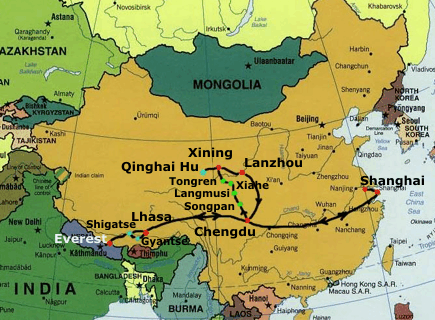
19-22 September:
Shanghai-Chengdu-Songpan-Langmusi
I arrive in Langmusi after more than 20 hours by bus, through mountains, green prairies, yaks and deep blue skies. On the hills, prayer flags are waving in the wind, spreading mantras in the air. These flags are to be found in all sacred spots (mountains, lakes, passes) and will accompany me during all the following days. I make a one night stop in Songpan (see CC Pt.8). It’s colder than expected.
On the last bus to Langmusi the only other foreigner is Takuo, a Japanese guy who is on a Round The World tour. We will travel together for 4 days. The other travellers are locals, mainly Tibetan, and whenever we reach a mountain pass they throw confetti with mantras from the bus windows.
At 3,500 m above sea level, Langmusi is a charming Tibetan village, on the border between Sichuan and Gansu Provinces. There are two monasteries – one on each side of the river – and one mosque for the large Muslim community.
One of the main attractions of Langmusi is the sky burial. In Tibetan tradition, the dead are neither cremated (it would be a waste of wood) nor buried (in wintertime the soil is too hard), but offered to the sky. Sky burials are still performed in Inner and Outer Tibet: a burial ground is prepared on a hill off-sight and the corpses are chopped in pieces and left for vultures and birds of prey to eat. In the picture you can see the sky burial ground of Langmusi. Nobody dies while we are in town, so all we get to see are some axes and some sparse bones from the days before…
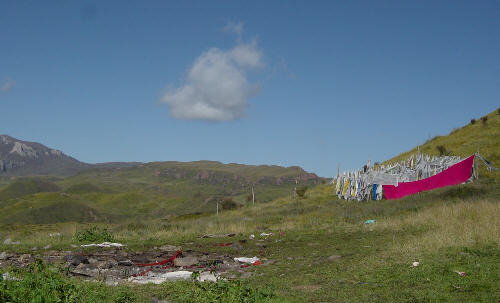 Sky Burial Ground in Langmusi
Sky Burial Ground in Langmusi
Other highlights of Langmusi: the swine on the roads and the monks playing games in the internet cafe’.
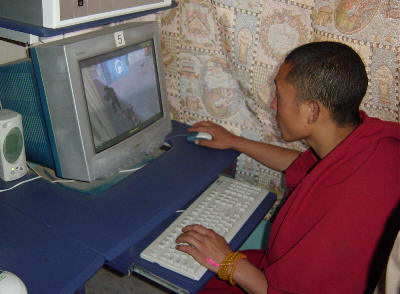
23-24 September
Langmusi-Xiahe
We are “adopted” by a group of art students from Hangzhou and we travel together to Xiahe (Gansu).
Labrang Monastery is the biggest Tibetan monastery outside of T.A.R. and is a very popular spot for pilgrims from the adjoining regions. There are prayer wheels along the perimeter of the monastery (a 3km circuit) and pilgrims cover it repeatedly at a fast pace from dawn till dusk.
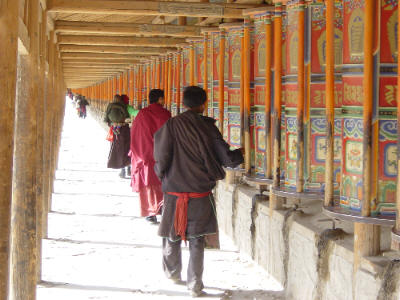
It is a striking view and my first contact with the Kora (another recurring ritual during this trip): to expiate a bad karma, the pilgrims repeatedly cover the perimeter of temples, monasteries, sacred lakes and mountains, always clockwise, turning the prayer wheels and constantly repeating the formula “Om Ma Ni Pad Me Hum”. The most devout do the kora prostrating, wearing apron and knee-pads to protect their clothing. Inside the temples, people offer scarves, money, hairpins, fruit and yak butter (used as wax for the candles). I spend hours just watching the pilgrims.
25-26 September
Tongren and Qinghai Hu
Tongren is another Tibetan village, off the usual tourist routes, where I arrive in the middle of a huge lama convention. A large crowd of monks and Tibetan women with long braids bound together at the extremities is gathered in the courtyard of the main temple and listens to the chants of the lamas.
I leave for Xining, the capital of Qinghai Province. I spend one day on the shore of Qinghai Hu (China’s biggest lake), among herds of yaks, sheep and friendly shepherds. Apart from some moments of panic when I end up in the middle of some yaks not exactly happy to see me, I have a wonderful afternoon. On the way back, I meet 3 pilgrims who are doing the kora of the lake (more than 200 km)… prostrating! It will take them one month to do it.
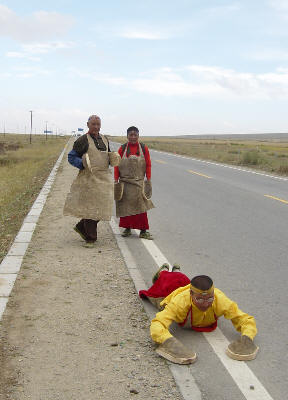
27-28 September
Xining-Lanzhou-Chengdu-Lhasa
Potala Palace in Lhasa is very popular in China, where you find it on banknotes and in posters on restaurant walls. Finding yourself in front of it is overwhelming.
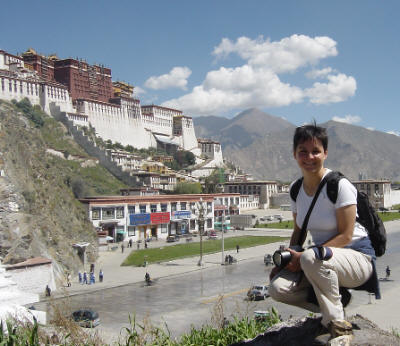
At 3,700m of altitude, Lhasa is a very lively town. The circuit around Jokhang Temple (the Barkhor) swarms with pilgrims who are doing the kora with hand prayer wheels and rosaries. The vendors call out the usual “Looke, looke, cheap cheap” or the so far unheard “I love you!”. Differently from Outer Tibet, here men wear their hair long and in a braid, tied with a red or black ribbon. The women smile at me and show their tongues, in an old form of greeting.
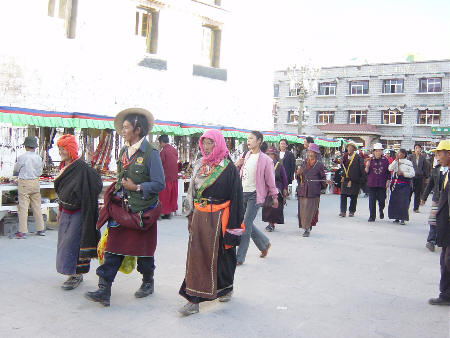 The Barkhor
The Barkhor
29 September – 6 October
Lhasa-Shigatse-Sakya-Everest Basecamp-Gyantse
I rent a land-cruiser together with 3 other people: Oystein and Corinna from Norway and Alex from Berlin. Our driver will stay nameless during the whole trip: Tibetan names seem to create even more retention problems than Chinese ones. After having asked him 4 times we give up... He’s a good driver and mechanic, but there are huge difficulties in communicating. During the longest conversation of the trip Oystein learns that the driver has 10 children at home; after some days it turns out he has only one 10 year old son.
We leave Lhasa, headed to the Everest Base Camp, but there’s a big question mark: will we be able to reach 5,200 m without suffering from altitude sickness? The others had 2-3 days to acclimatise in Lhasa and I hope that my week in Outer Tibet (around 3,500 m) proves to be enough for my body to cope.
During the next 7 days it’s villages, monasteries, monks, the unmistakeable scent of yak butter, potatoes/rice/eggs for breakfast/lunch/dinner, guesthouses with no water that nobody has cleaned for weeks, very dusty roads (the visibility INSIDE the jeep decreases considerably every time we drive into a pothole), passes more than 5,000 metres high.
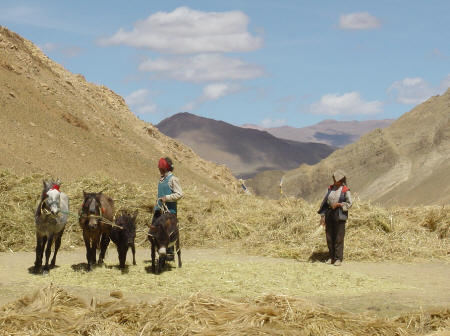
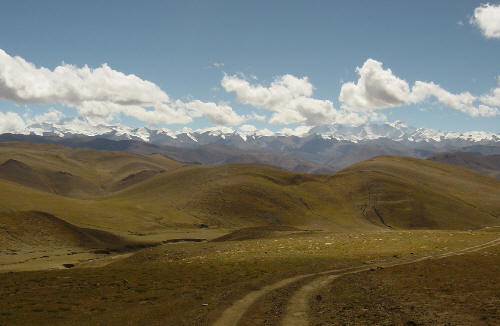
On the 1st of October we sight the Himalayas, with 4 peaks over 8,000m. Mount Everest stands out and the panorama is spectacular. When we finally get to Rongbuk (at 5,200 m the highest monastery of the world), the north face of Mt. Everest dominates the valley in front of us. There are no clouds at all.
We stop at a dormitory next to the monastery, on beds that haven’t seen fresh linen for a while, but the view from the windows is breathtaking! It’s very cold, though you can’t miss the sunset… so in my 20 layers of clothing I stay outside to watch the light change on the North Face.
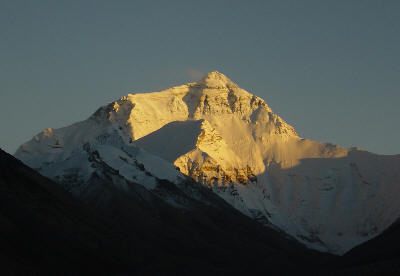
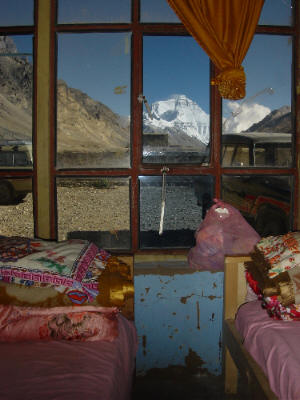 room with a view
room with a view
The next day I walk the few kilometres that lead to the Base Camp (taking it very easy: the altitude is noticeable!), where the wind blows us away.
Then back towards Lhasa, stopping in Gyantse. If compared to Lhasa and Shigatse, Gyantse has maintained more of its Tibetan character. Every family seems to have at least one cow tied outside their homes (apart from the milk, they deliver excrement which dries in heaps under the sun and is used as construction material for houses and walls). People are particularly friendly and the general atmosphere is very pleasant.
On the seventh day, right after the last pass on the way to Lhasa, we damage the rear axle of our jeep. The driver finds a temporary solution, which makes us close the week without any serious incidents.
 Yamdrok-So
Yamdrok-So
Back in Lhasa, I still have time to go to the Barkhor, for one last sight of the pilgrims doing the kora around the temple.
On the sixth of October I leave for Chengdu and Shanghai.
Other Pictures of this trip:
| CC Part 8 | CC Index | CC Part 10 | ||